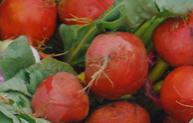Radishes

Growing Radishes
Varieties
Common
Cherry Belle, Monica, Tinto, Red Satin, Kasper.
Chinese (Lo Bok)
Mino Summer Cross, Everest.
Japanese (Daikon)
Relish Cross, April Cross, Omny.
See your seed dealer for the most recent variety recommendations.
Seed Treatment
Use only hot-water-treated seed when planting into new land where radishes have not been grown. If damping-off has been a problem, treat seed with Thiram seed protectant, according to label directions.
Seeding
Use a drill with a scatter shoe to drop 21 seeds 15 mm deep every 25 cm of row. Space rows 20 cm apart.
Fertilizer
A soil test is necessary to determine phosphate and potash requirements. Use the Vegetable Production Guide: Nutrient Management (PDF) for recommendations based on soil test results.
Muck Soils
Broadcast and incorporate 70 kg/ha (28 kg/acre) nitrogen and all of the required phosphate and potash.
If fertilizer is to be banded at time of seeding, rates greater than 70 kg/ha (28 kg/acre) of potash should be broadcast and incorporated prior to seeding.
Radish Weed Management
Roundup may be used as a pre-emergence treatment to kill all weeds present, prior to planting. See “Stale Seedbeds section of the Vegetable Production Guide: Pest Management (PDF, 1.2 MB).
Radish Insect Management
Root Maggots
Small flies lay eggs in soil near plants throughout the season. White maggots tunnel and etch surface of roots, making them unmarketable.
Control
See table below. For Lo Bok recommendations, see the Specialty Vegetables section of this guide.
| Product | Rate | PHI* | Comments |
|---|---|---|---|
Verimark(cyantraniliprole) |
10 to 15 mL of water per 100 m of row | 21 |
|
*PHI = Pre-harvest interval
BUFFERS – Refer to product label for buffer requirements, and consult the Vegetable Production Guide: Pesticide Regulations and Safety (PDF).
PESTICIDE GROUP DETAILS – see the Vegetable Production Guide: Pesticide Toxicity Table (PDF).
Radish Disease Management
Black Root (Aphanomyces)
Black, constricted bands girdle roots.
Control
Grow only small globe-type varieties, as they are not seriously damaged. In new land, where the disease has not occurred, use hot-water-treated seed to avoid introducing the fungus. Diseased refuse should be plowed under deeply. Provide good soil drainage and follow a 4-year rotation.
Downy Mildew (Peronospora)
Downy mildew frequently occurs in late summer and fall, and shows as a white, fuzzy fungus in patches on the undersides of leaves and rough blackened patches on roots.
Control
- Avoid planting radishes after radishes in the same year.
- Bury crop remains or remove them from field after harvest to prevent carry-over of diseased refuse, control volunteers and wild radish.
- Reduce density of plantings in the late summer to improve air circulation.
- Increase the phosphorus to potassium ratio of the fertilizer applied prior to late seedings.
| Product | Rate | PHI* | Comments |
|---|---|---|---|
Ridomil Gold 480 SL(metalaxyl – M & S Isomer) |
1.2 to 2.4 L/ha (480 to 980 mL/acre) |
21 |
|
*PHI = Pre-harvest interval
BUFFERS – Refer to product label for buffer requirements, and consult the Vegetable Production Guide: Pesticide Regulations and Safety (PDF).
PESTICIDE GROUP DETAILS – see the Vegetable Production Guide: Pesticide Toxicity Table (PDF).
